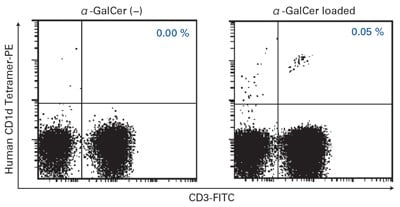CD1d
CD1d molecules are non-polymorphic MHC class I-like proteins. These are a type of non-classical MHCs. They present phospholipid and glycosphingolipid antigens to invariant Natural Killer T (iNKT) cells, a subset of CD1d-restricted T cells. This axis is involved in the regulation of nearly all aspects of the innate and acquired immune responses.1 These iNKT cells an bridge the innate and acquired immune pathways. On activation, these cells can assume a Th1, Th2 or Th17 immune functionality profile. They can then directly exhibit cytotoxicity. The CD1d-iNKT cell axis plays a significant role in the antimicrobial, antitumor and autoimmune response.1
The CD1d molecules are expressed on myeloid cells as well as lymphoid cells. They are also found on epithelial and vascular smooth muscle cells. These are regulated by multiple transcription factors including TFSP1 and LEF-1 in humans and members of the ETS family in mice.1
Lipid presentation by CD1d occurs at the surface. CD1d undergoes internalization and trafficking to the cytosol in lysosomal and endosomal compartments from cell surface. The CD1d molecules exchange their ligands with glycolipids and return to the surface. The glycolipids may be acquired from exogenous sources or endogenous to the cell. The lipids are presented at the surface by the CD1d molecules.1 Ligands that can be presented by CD1d molecules include bacterial glycolipids, glycolipids from a marine sponge α-galactosylceramide (α-GalCer), normal endogenous glycolipids and glycolipids and phospholipids derived from tumors. Some ligands are also non-lipidic molecules.2 CD1d loaded with α-GalCer can activate human and murine CD1d-restricted NKT cells.
MBL International offers CD1d tetramers
MBL International offers CD1d tetramers. These prepared by tetramerization of complexes of CD1d and β2m by PE- or APC- labeled streptavidin. Binding this reagent to α-GalCer enables highly sensitive detection of CD1d-restricted NKT cells and can be combined with antibodies to study NKT cell function through flow cytometry.
α-GalCer loaded and α-GalCer unloaded tetramers are available.
Dissolving and loading α-GalCer on CD1d tetramer

Experimental protocols: Detection of human NKT cells with CD1d tetramer
PBMC were separated from peripheral blood of healthy subjects and incubated at room temperature for 5 minutes with 40 µl of Clear Back (Human Fc receptor blocking reagent, MBL code no.MTG-001). CD3-FITC and human CD1d tetramer-PE (with or without binding of α-GalCer) were added and incubated for 30 minutes at 4°C protected from light, and cells were analyzed by flow cytometry.
Results showed total cells contained 0.05% NKT cells, as defined by CD1d/CD3 dual positivity.

Research highlights
- Lei Z, et al. demonstrated that Cd1d expression was decreased significantly in mouse hepatocytes upon S. japonicum infection. S. japonicum is a key causative agent of a highly prevalent and neglected tropical disease, schistosomiasis. This presents an opportunity for hepatocyte CD1d as a target for alleviating schistosomiasis clinical outcomes.3
- Ayaka H, et al. assessed the CD1d expression on glioblastoma cells to determine whether iNKT cells can be used to exert anti-tumor effects. The study showed that CD1d expression bears potential as a target for NKT cell-based glioblastoma immunotherapy.4
- Almeida CF, et al. demonstrated that non-lipidic small molecules serve as a target for polyclonal type II NKT cells that are CD1d restricted. These molecules bear similarities with sulfa drugs involved in systemic hypersensitivity and drug-allergy reaction.5
References
- Mohammed SC, et al. J Immunol. 193(10): 4761-4768 (2014)
- Randy RB, J Immunol. 177(2): 769-775 (2006)
- Lei Z, et al. Immunology 162(3): 328-338 (2021)
- Ayaka H, et al. Cancer Immunol Immunother. 70(5): 1239-1254 (2021)
- Catarina FA, et al. Proc Natl Acad Sci U S A. 118(34); e2104420118 (2021)
- Stephane S, et al.. J. Immunol. Methods 268: 107-121 (2002)
- Matsuda JL, et al. J. Exp. Med. 192: 741-754 (2000)
- Benlagha K, et al. J. Exp. Med. 191: 1895-1903 (2000)
For Research Use Only. Not for use in diagnostic procedures.




